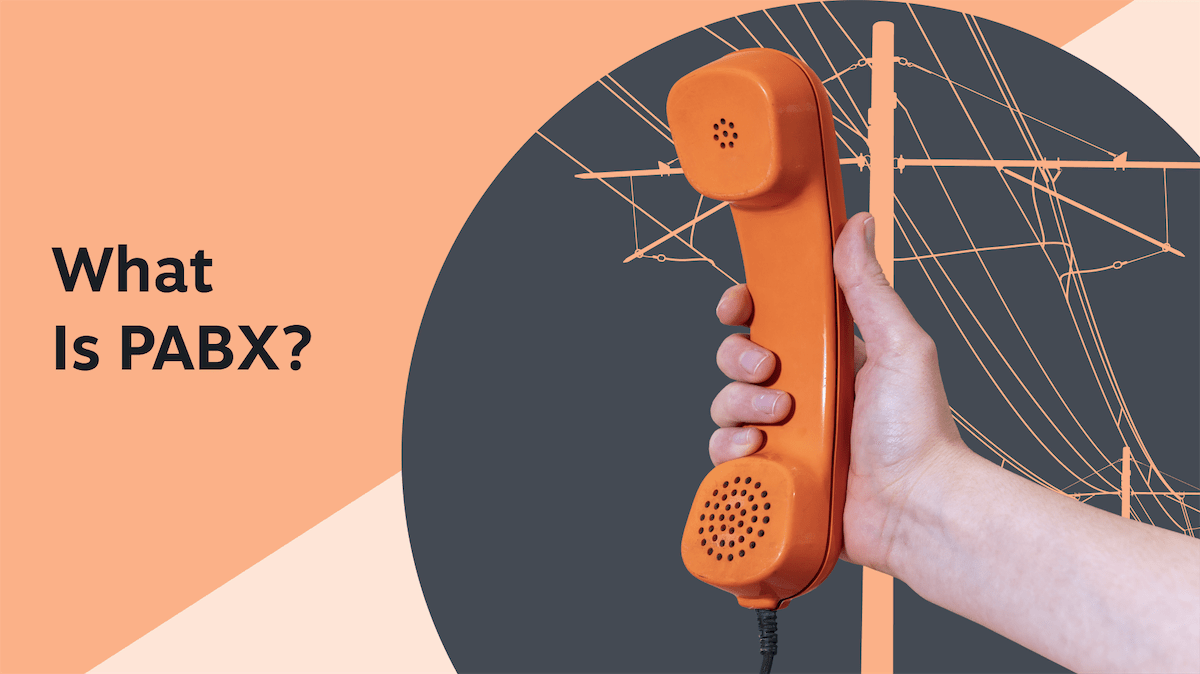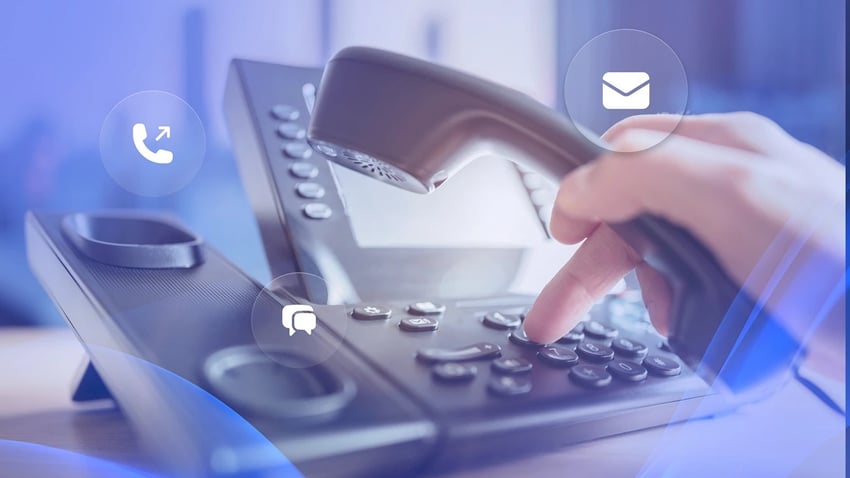A PABX is more or less synonymous with an upgrade of the corresponding private branch exchange (PBX).
PABX systems have evolved enormously over the past few decades — from purely analog systems to today’s digital PABX solutions that use voice-over IP (VoIP service) and bring a host of advanced features.
In this article, we’ll overview PABX systems, explore their key components, and discuss the benefits they offer businesses over standard phone lines.
Whether upgrading your telephony infrastructure or learning more about this integral tool for organizational communication, this article will get you up to speed on private automatic branch exchanges.
What Is PABX?
PABX stands for private automatic branch exchange. It’s a private telephone network used within an organization to allow internal communication and connection to the public switched telephone network (PSTN).
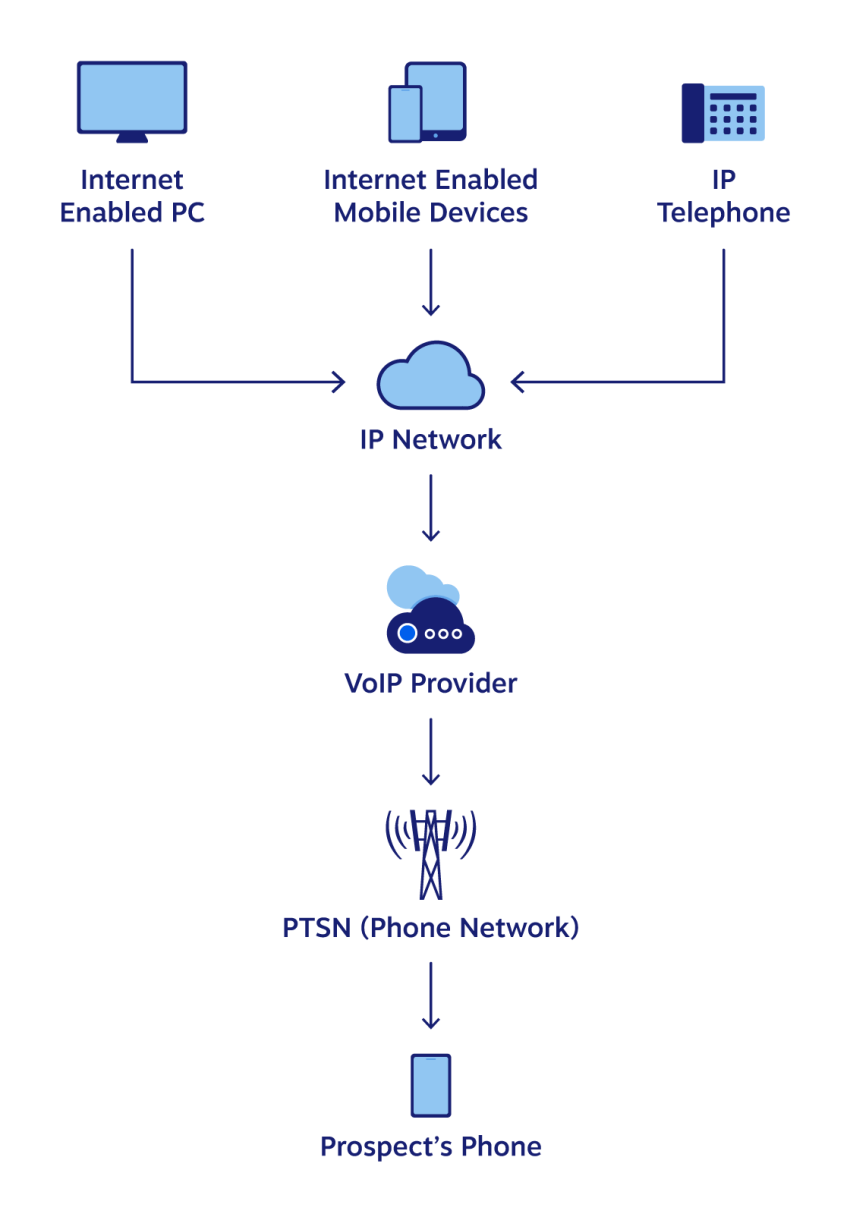
PABX offers a business solution for companies that need many lines for in-house and outside calls. It lets companies use a single access number with several extensions, which is cheaper than using many separate direct landlines linked to the public network.
A company that uses PBX or PABX acts like a telephone exchange within its facilities. PABX automates the switching tasks needed to connect calls between extensions.
That’s the “A” in the acronym — it means automatic. In contrast, traditional PBX systems need human switchboard operators to manually connect phone users.
A PABX system is often owned and administered by the company hosting it on its premises. Many call centers and large enterprises use PABX to handle high call volumes efficiently. Common features include auto attendant, call conferencing, call holding, call forwarding, voicemail, and call transfer.
Modern PABX systems use VoIP technology, which is lower cost and has better scalability than legacy landline systems. Cloud-based PABX solutions are also now available.

What Is the Difference Between PBX and PABX?
PBX and PABX are both private telephone networks. The terms are sometimes used interchangeably when referring to private business phone networks.
The key difference is that PABX systems automate the call-switching process, while PBX originally referred to manually operated switchboards, but it can also be automated.
PABX emerged later as an automated system using computerized switching equipment instead of manual switchboard operators. This automated the call routing within the private phone network.
| Feature | PBX | PABX |
|---|---|---|
| Definition | Private Branch Exchange | Private Automatic Branch Exchange |
| Automation | Manual (originally) – required operators | Automatic – no operators needed |
| Switching System | Manual (operators physically plugged wires) | Automatic – electronic switching |
| Features | Limited (basic call routing) | Advanced (IVR, voicemail, conferencing, etc.) |
| Technology | Analog | Analog or digital (including IP) |
| Use Cases | Outdated – mainly historical interest | Businesses of all sizes, modern phone systems |

How Does a PABX System Work?
Modern PABX systems interface with the public phone network and route calls digitally using Session Initiation Protocol (SIP) and VoIP technologies.
PABX works like a mini version of a public telephone exchange. A typical system has both software and hardware, including telephone units, routers, fax machines, modems, hubs, adapters, and switches.
A company can run its internal phone network using local phone extensions with PABX. These extensions correspond to specific phones and devices used in the corporate building.
This system simplifies internal telephone communication. In-house calls don’t need to go beyond the local network, and users can also make in-house connections with the touch of a button.
A PABX often greets an incoming call with a recorded message. This greeting is also called Interactive Voice Response (IVR). It usually requests a number for the caller to dial to reach the correct department or say their commands.
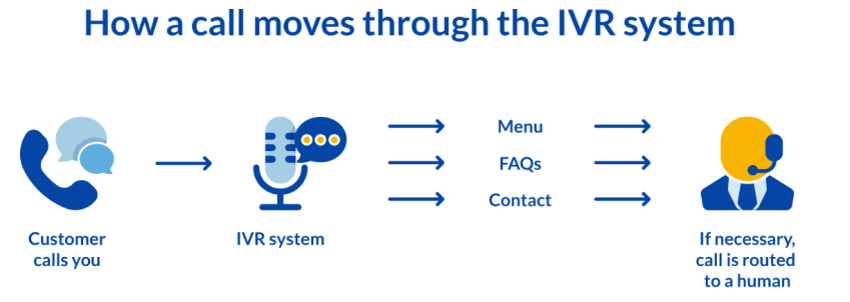
The PABX routes incoming calls based on the code or extension number.
For outgoing calls, a PBX connects with the public telephone exchange. A traditional PBX has one or more external (trunk) lines. It has a fixed number of internal lines (extensions) connected to the trunk line. Staff and other local users need to share the external lines to make outside calls.
Evolution of PABX
The PABX system has advanced significantly over the years. Here’s a quick overview of the different types of PABX systems and their evolution:
1. Analog PABX
Analog PABX systems have been around since the late 19th century. They use analog signals and PSTN over copper wiring to connect extensions to a central control unit.
Tradition PABX systems were limited in features and functionalities, prone to signal degradation over distances, and difficult to reconfigure or scale up.
But they did offer some benefits. The traditional PBX was inexpensive to install and operate, easy to troubleshoot and maintain, and reliable and durable hardware. But times have changed.

2. Digital PABX
Digital PABX systems were introduced in the 1970s and have mostly replaced analog systems today. They use digital signals instead of analog ones.
They support more extensions and lines, offer advanced call routing features, are easy to reprogram and scale up, and provide more reliable voice and data transfer.
3. Cloud-based PABX
With the rise of VoIP, cloud-based PABX solutions have emerged. These systems use cloud infrastructure rather than on-premise hardware.
Cloud-based PBX systems are better. They can have a limitless number of lines or extensions, and the Internet protocol also allows multimedia communications.
Key Features of PABX Systems
A PABX allows organizations to use more phone units than their physical phone lines. Companies just need to assign extension numbers to each telephone unit. Moreover, PABX users can have internal calls for free.
The following basic functions and advanced features are available in most PABX systems:
1. Call routing and forwarding
- Auto Attendant (Digital Receptionist): Automatically connects callers to the target extension number using a menu.
- Call Forwarding: Lets admins route incoming calls based on specific criteria.
- Call Transfer: Enables a user to hand off a live call to another user or extension.
- Voicemail: Provide callers with the option to leave a voicemail message to ensure you can follow up.
- IVR: Works like an upgraded auto attendant for account inquiries, product information requests, and other purposes.
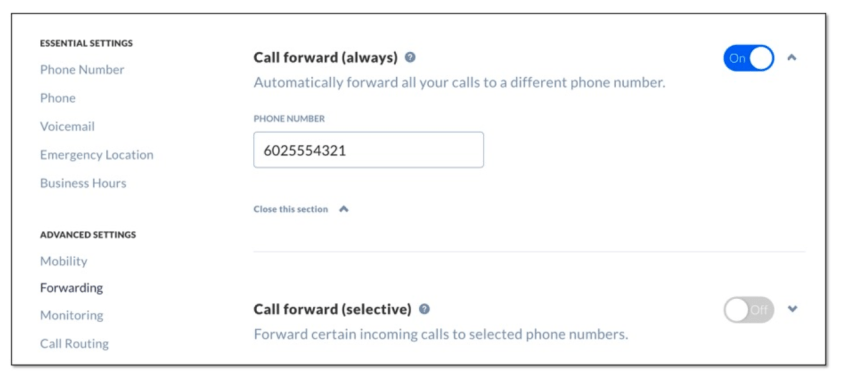
2. Mobility and remote work capabilities
- Automatic Ring Back: Enables users to pre-dial a busy line and receive a ring back when it’s available, supporting remote/mobile workers.
- Direct Dial Numbers: Allows callers to bypass IVRs to connect to intended numbers directly.
2. Conferencing and collaboration tools
- Conference Call: Allows speaking with more than one party at the same time.
- Call Parking: Allows users to put an ongoing call on hold on one device and continue on another.
- Call Recording: Used for documentation, monitoring, training, or other purposes by integrating with other applications.
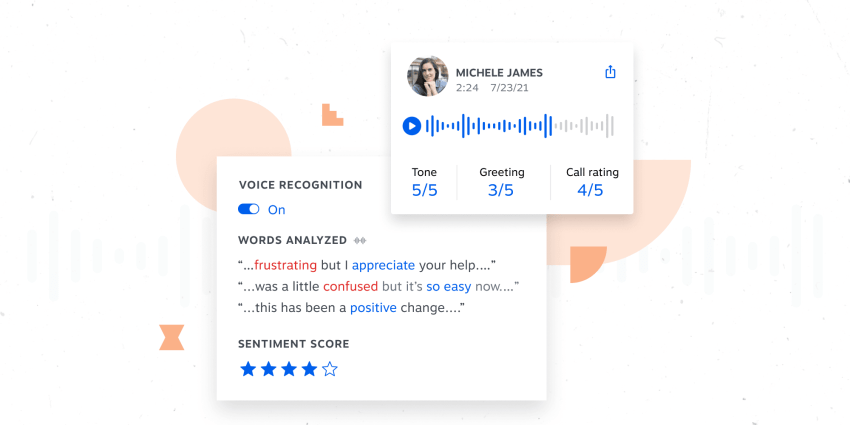
4. Security and reliability
- Do Not Disturb (DND): Blocks incoming calls to a specific extension.
- Ring Groups: Instructs phones to ring in sequence or simultaneously for reliability.
Benefits of PABX
PABX offers lower costs, flexibility to grow, advanced features, centralized management and control, professionalism, and integration with cutting-edge technologies. Here are some of the main benefits of using a PABX phone system:
- Cost Savings – PABX systems allow businesses to use internal extensions to connect employees. This reduces the need for external phone lines and saves on telephone service costs.
- Scalability – PABX systems can be easily expanded by adding new extensions as a business grows. This eliminates the need to install an entirely new phone system.
- Advanced Features – Modern PABX systems include advanced features like auto attendants, voicemail, call routing, caller ID, call monitoring, and more. This improves communication and productivity.
- Centralized Control – PABX systems are centrally controlled, making it easier for administrators to manage the entire phone network of a company from one location. Settings and configurations can be applied globally.
- Improved Professionalism – With features like auto attendants, voicemail, and call routing to the right extensions, PABX systems help project a professional image for businesses. This makes for better customer service.
- Integration Capabilities – Many PABX systems have APIs to integrate with CRM software, AI chatbots, and other helpful technologies. This further boosts productivity and service quality.
- Mobility Options – Some modern systems come with mobile apps or have mobile phone integration. This allows employees to have flexible call options and lowers business phone costs.
How To Choose the Right PABX System
When thinking about using a PABX, it all boils down to choosing the right solution. How? Here are 6 key considerations for choosing a PABX system.
- Consider your business needs. Evaluate number of employees, phone lines required, features like call routing, voicemail, etc. A growing business will need a scalable system.
- Look at hardware and deployment options. PABX systems can be hardware appliances, software-based, or cloud-based for flexibility.
- Ensure scalability for future growth. The system should allow easy addition of extensions, lines, and advanced features. A cloud-based PABX offers more scalability.
- Check reliability and redundancy. The system must have dual power supplies, and failover mechanisms to avoid any downtime.
- Evaluate call quality. The system should offer clear call quality even during peak usage periods through sufficient bandwidth allocation.
Migrate Your PABX To the Cloud
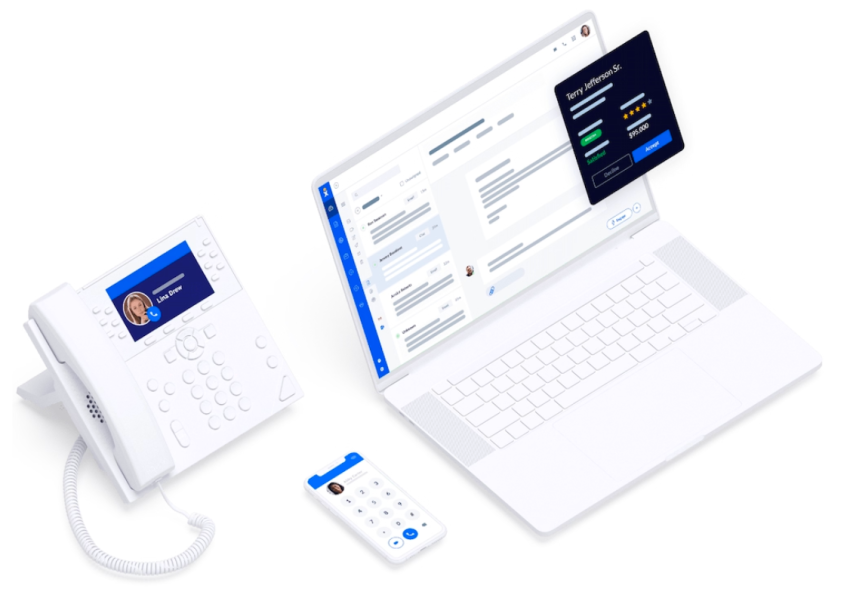
PABX gives businesses more control and flexibility over their voice communication processes. It’s a viable solution for internal collaboration. It’s also perfect for making and receiving outside calls. But installing expensive hardware can be a pain for many businesses.
Thankfully, many ways exist to build an IP PABX/PBX system. The two most common are:
- Start from the ground up. The better and more affordable option for this case is to go for a hosted IP-based PBX system.
- Upgrade existing traditional (landline) telephone systems. Integrate existing phone numbers and hardware via a SIP trunk provider.
Both methods use an internet connection to improve business telephony. They use ISDN (Integrated Services Digital Network) to process different types of data. Treat both as a data network rather than just voice.
To simplify the work, VoIP phone services like Nextiva give businesses more control and flexibility over their voice communication processes. Its cloud-based model also provides the flexibility to scale up or down as business needs evolve.

For any company looking to enhance its telephony capabilities, Nextiva is the best replacement for an IP PBX or a traditional PABX solution.
FAQs on PABX
How much does a PABX system cost?
Costs can vary widely depending on the size and features of the PABX system. Small systems for a few dozen employees may cost a couple thousand dollars. Larger corporate systems support thousands of users; advanced features like call routing and AI-powered IVR systems can cost more. Talk to your VoIP provider for more details.
Thanks to the simplification of cloud platforms, no deep technical skills are required. However, some IT expertise or vendor support is still recommended to handle setup, maintenance, and getting the most out of a new phone system. Cloud-hosted VoIP systems like Nextiva are designed to simplify setup for most businesses. The vendor hosts the core phone system remotely, so no on-site hardware installation is needed. We have admin dashboards and guides to walk you through configuration.
Can PABX systems integrate with other business tools?
Many PABX systems offer integrations with CRM, calendar, and other business tools for improved collaboration and efficiency. Leading hosted PABX solutions like Nextiva include common app integrations and open APIs to build connections. This means your phone system data can sync with tools your team may already use daily for sales, support, and operations.
Are PABX systems secure and reliable?
Yes, business phone systems like PABX are secure and reliable when acquired from reputable enterprise-grade providers, especially today’s cloud-hosted PABX solutions. While no phone system is 100% immune to incidents, business-grade PABX platforms are engineered for enterprise contact center solutions, availability, and call quality across the board. Proper vendor selection ensures minimal disruption risk and authorization access.

















 VoIP
VoIP 

